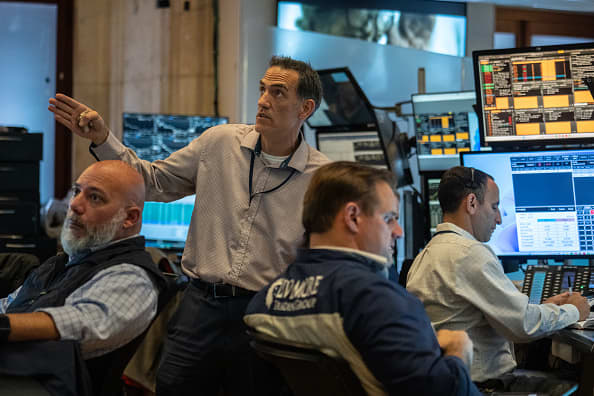Investors believe the fears about the slowing economy are overblown and market is overreacting

It’s been a rough few days on Wall Street. Stocks tumbled to start the week after a disappointing July jobs report on Friday sparked fears of an incoming recession, a concern that worsened over the weekend amid a global market sell-off. Japan stocks are in a confirmed bear market, with the Nikkei plunging 12.4% and posting its worst day since Black Monday of 1987. On Monday, the Nasdaq Composite pushed deeper into correction territory, down more than 13% from the all-time high it reached just last month. The S & P 500 is off by nearly 9%, and it could soon join the tech-heavy index. The Dow Jones Industrial Average has tumbled more than 6% from its recent high. That, plus falling U.S. Treasury yields, as well as a spike in Wall Street’s fear gauge to its highest level since 2020 , has investors increasingly skittish about markets and the economy. The prospect of an emergency rate cut by the Fed added to those fears. .VIX 1D mountain VIX On Wall Street, however, many investors expect the fears of a slowing economy are overdone, and that markets are overreacting. They argue the sell-off has been long overdue, given the extent of this year’s rally, and many expect the pullback could soon represent a buying opportunity — especially in the lagging tech trade. “It looks like this is a little bit more panic selling than it should be,” said Mark Malek, chief investment officer at Siebert. “At some point, you would hope that the cooler minds come in and look at it as a buying opportunity — one that they haven’t had in many months, but possibly are being presented with right now,” Malek added. Continued strength The disappointing July nonfarm payrolls report may have spurred fears of a downturn, but many investors are doubtful that such a scenario will materialize given what they see as the ongoing strength of both the economy and company reports in the second-quarter earnings season. As of Aug. 1, the U.S. economy is expected to expand by 2.5% in the third quarter, according to the Federal Reserve Bank of Atlanta’s GDPNow estimate. Meanwhile, U.S. companies are on pace to post their highest year-over-year earnings growth rate since the fourth quarter of 2021, according to a Friday note from FactSet senior earnings analyst John Butters. In the second quarter, the S & P 500 blended earnings growth rate — which includes actual results, as well as estimates for companies that have yet to report — is expected to be 11.5% on a year-over-year basis. Given these numbers, the stock slide of the last three trading sessions appears to have more to do with valuations than they do with the economic or earnings outlook. Historically speaking, the stock market has experienced one 10% correction per year, on average, according to Bank of America. “We don’t see an earnings recession, we don’t see an economic recession,” said Sam Stovall, chief investment strategist at CFRA Research. “But we do see the need for valuations to be brought back in line with historical averages.” Stovall noted the S & P 500, which is currently trading at 20.9 times forward earnings, has fallen somewhat after trading at 22 times earlier this year. However, that’s still above the 20-year historical average of around 16.5. The strategist expects the S & P 500 could fall into a correction, somewhere between 10% and 15%. To be sure, investors who aren’t expecting a recession say any weakness in the consumer should continue to be monitored. “What we really need to focus on, which is the challenge now, is if we start to see consumer confidence fade, and we see consumption fading, then we have to be really concerned about a recession,” Siebert’s Malek said. ‘First to worst’ For long-term investors, the sell-off could soon represent a good opportunity to buy back into a market that started to appear frothy earlier this year. Jamie Meyers, senior analyst at Laffer Tengler Investments, said he’s now considering adding Nvidia to the firm’s growth strategy. The artificial intelligence beneficiary has doubled this year, but it’s more than 28% off its recent high. On Monday, it was down 6%. “Nvidia is a name that we’ve wanted to add for a long time, but it’s never been cheap enough on our valuation metrics. And every time I’ve said, you know, ‘let’s wait for a pullback,’ it just keeps going up,” said Meyers. “So, I mean, I think now would be the time to start thinking about adding [to it].” In fact, the market pullback could be good for the tech trade, according to CFRA’s Stovall. If investors make it through a correction with recession calls in the rearview mirror, the strategist expects the mega-cap tech stocks could resume their leadership. All of the so-called Magnificent Seven names are more than 10% off their recent highs. “If we conclude this decline based on the lack of a fear of recession, then I think we basically go right back to where we were, in that investors will be gravitating towards those areas likely to show the greatest growth,” Stovall said. “And that would be your technology, communication services, maybe industrials and consumer discretionary.” Meanwhile, defensive stocks, such as consumer staples and health care, could go from “first to worst,” he said. For retail investors, the key would be to keep a long-term perspective and remain diligent, and remember that markets historically have recovered all their losses. “The worst thing you can do is sell at the bottom and then it goes back up. I mean, I think the message is, hold tight,” Meyers said. “And if you do have some cash on the sidelines, it might be time to start buying some high quality names you wanted to own for a long time.”
Source – CNBC




